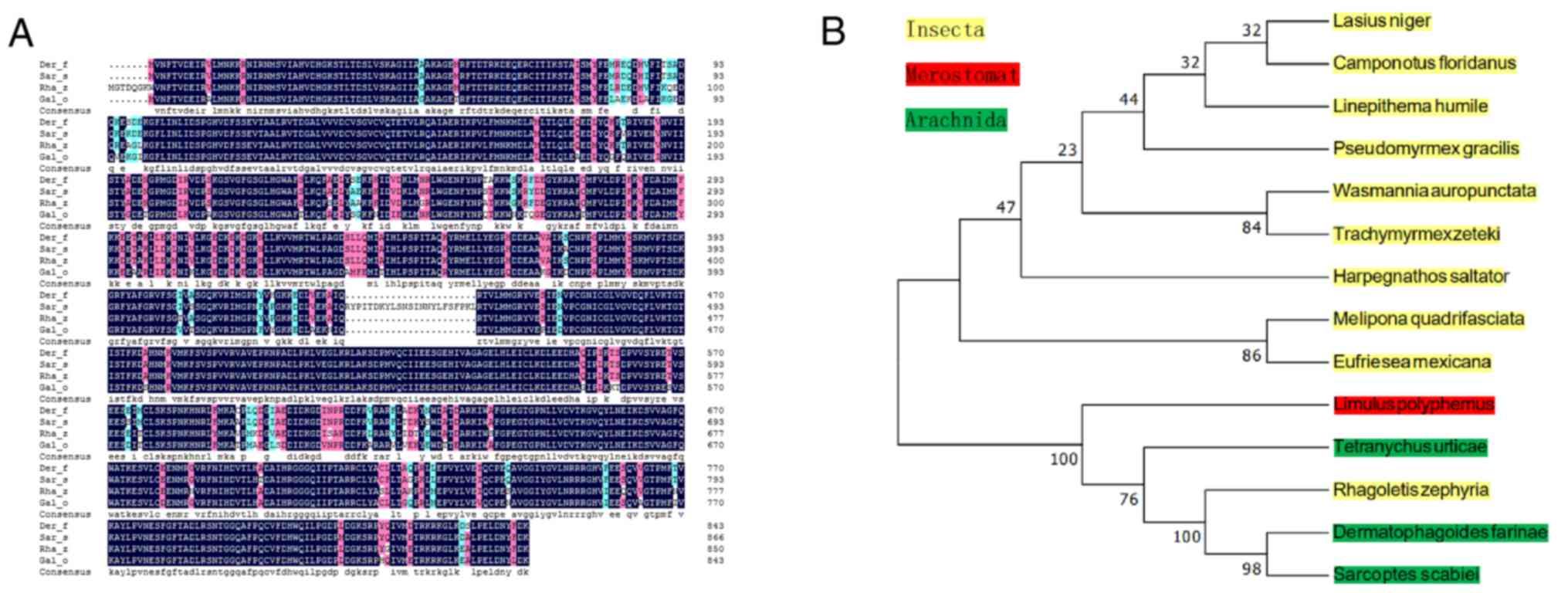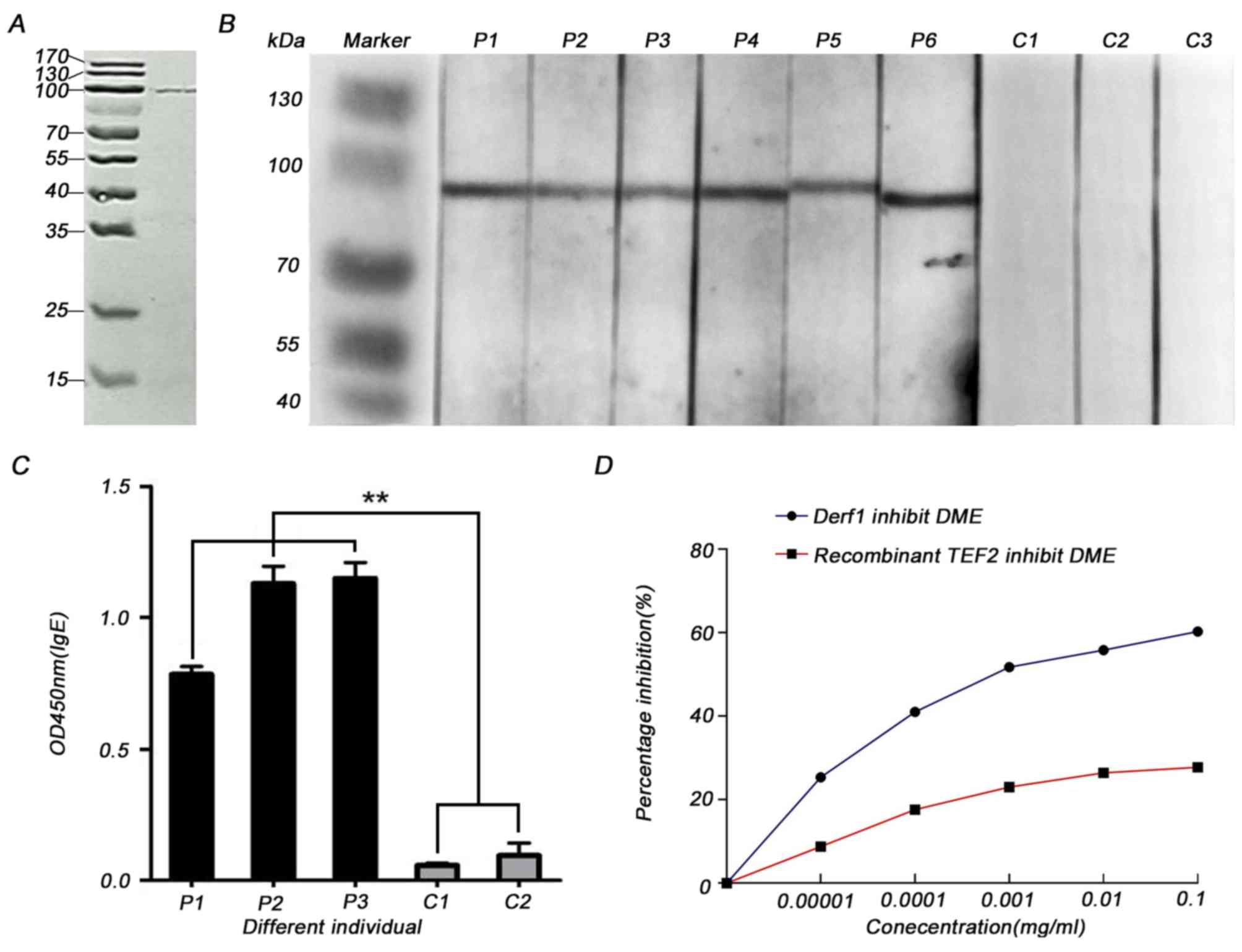|
1
|
Arlian LG: House-dust-mite allergens: A
review. Exp Appl Acarol. 10:167–186. 1991. View Article : Google Scholar : PubMed/NCBI
|
|
2
|
Pawankar R, Canonica G and Holgate S:
World allergy organization (WAO) white book on allergy. Update.
2013.PubMed/NCBI
|
|
3
|
Valenta R, Linhart B, Swoboda I and
Niederberger V: Recombinant allergens for allergen-specific
immunotherapy: 10 years anniversary of immunotherapy with
recombinant allergens. Allergy. 66:775–783. 2011. View Article : Google Scholar : PubMed/NCBI
|
|
4
|
Chapman MD, Smith AM, Vailes LD and Pomés
A: Recombinant allergens for immunotherapy. Allergy Asthma Proc.
23:5–8. 2002.PubMed/NCBI
|
|
5
|
Bousquet J and Michel FB: Specific
immunotherapy in asthma: Is it effective? J Allergy Clin Immunol.
94:1–11. 1994. View Article : Google Scholar : PubMed/NCBI
|
|
6
|
Thomas WR, Smith WA and Hales BJ: The
allergenic specificities of the house dust mite. Chang Gung Med J.
27:563–569. 2004.PubMed/NCBI
|
|
7
|
Valenta R and Niederberger V: Recombinant
allergens for immunotherapy. J Allergy Clin Immunol. 119:826–830.
2007. View Article : Google Scholar : PubMed/NCBI
|
|
8
|
Van Der Veen MJ, Jansen HM, Aalberse RC
and van der Zee JS: Der p 1 and Der p 2 induce less severe late
asthmatic responses than native Dermatophagoides pteronyssinus
extract after a similar early asthmatic response. Clin Exp Allergy.
31:705–714. 2001. View Article : Google Scholar : PubMed/NCBI
|
|
9
|
Trombone AP, Tobias KR, Ferriani VP,
Schuurman J, Aalberse RC, Smith AM, Chapman MD and Arruda LK: Use
of a chimeric ELISA to investigate immunoglobulin E antibody
responses to Der p 1 and Der p 2 in mite-allergic patients with
asthma, wheezing and/or rhinitis. Clin Exp Allergy. 32:1323–1328.
2002. View Article : Google Scholar : PubMed/NCBI
|
|
10
|
Meyer CH, Bond JF, Chen MS and Kasaian MT:
Comparison of the levels of the major allergens Der p I and Der p
II in standardized extracts of the house dust mite,
Dermatophagoides pteronyssinus. Clin Exp Allergy. 24:1041–1048.
1994. View Article : Google Scholar : PubMed/NCBI
|
|
11
|
Shakib F, Ghaemmaghami AM and Sewell HF:
The molecular basis of allergenicity. Trends Immunol. 29:633–642.
2008. View Article : Google Scholar : PubMed/NCBI
|
|
12
|
Chen DX, Zhou PK and Ran PX: Screening and
identification of dominant allergens of Dermatophagoides
pteronyssinus and Dermatophagoides farina. China Trop Med.
39:431–436. 2009.
|
|
13
|
Walker C, Muniz MF, Rolim JM, Martins RR,
Rosenthal VC, Maciel CG, Mezzomo R and Reiniger LR: Morphological
and molecular characterization of Cladosporium cladosporioides
species complex causing pecan tree leaf spot. Genet Mol Res.
15:152016. View Article : Google Scholar
|
|
14
|
Berthelot K, Lecomte S, Estevez Y,
Coulary-Salin B, Bentaleb A, Cullin C, Deffieux A and Peruch F:
Rubber elongation factor (REF), a major allergen component in Hevea
brasiliensis latex has amyloid properties. PLoS One. 7:e480652012.
View Article : Google Scholar : PubMed/NCBI
|
|
15
|
Chen R and Snyder M: Promise of
personalized omics to precision medicine. Wiley Interdiscip Rev
Syst Biol Med. 5:73–82. 2013. View Article : Google Scholar : PubMed/NCBI
|
|
16
|
Bahcall O: Precision medicine. Nature.
526:3352015. View
Article : Google Scholar : PubMed/NCBI
|
|
17
|
Ghaffari-Nazari H, Tavakkol-Afshari J,
Jaafari MR, Tahaghoghi-Hajghorbani S, Masoumi E and Jalali SA:
Improving Multi-epitope long peptide vaccine potency by using a
strategy that enhances CD4+ T help in BALB/c mice. PLoS
One. 10:e01425632015. View Article : Google Scholar : PubMed/NCBI
|
|
18
|
Nezafat N, Ghasemi Y, Javadi G, Khoshnoud
MJ and Omidinia E: A novel multi-epitope peptide vaccine against
cancer: An in silico approach. J Theor Biol. 349:121–134. 2014.
View Article : Google Scholar : PubMed/NCBI
|
|
19
|
Shahsavandi S, Ebrahimi MM, Sadeghi K and
Mahravani H: Design of a heterosubtypic epitope-based peptide
vaccine fused with hemokinin-1 against influenza viruses. Virol
Sin. 30:200–207. 2015. View Article : Google Scholar : PubMed/NCBI
|
|
20
|
Chan TF, Ji KM, Yim AK, Liu XY, Zhou JW,
Li RQ, Yang KY, Li J, Li M, Law PT, et al: The draft genome,
transcriptome, and microbiome of Dermatophagoides farinae reveal a
broad spectrum of dust mite allergens. J Allergy Clin Immunol.
135:539–548. 2015. View Article : Google Scholar : PubMed/NCBI
|
|
21
|
Lin JL, Wang YY, Xiao XJ, Wu YL, Sun BQ,
Gao AJ, Liu ZG, Li J, Yang PC and Liu XY: Characterization of a new
subtype of allergen in dermatophagoides farinae-Der f 28. J Thorac
Dis. 7:1842–1849. 2015.PubMed/NCBI
|
|
22
|
Lafarga T, O'Connor P and Hayes M:
Identification of novel dipeptidyl peptidase-IV and
angiotensin-I-converting enzyme inhibitory peptides from meat
proteins using in silico analysis. Peptides. 59:53–62. 2014.
View Article : Google Scholar : PubMed/NCBI
|
|
23
|
Thirugnanasambantham K, Muralidaran S and
Mandal AK: Molecular cloning, computational and expression analysis
of anthocyanidin reductase in tea (Camellia sinensis). Appl Biochem
Biotechnol. 174:130–145. 2014. View Article : Google Scholar : PubMed/NCBI
|
|
24
|
Yu CS, Lin CJ and Hwang JK: Predicting
subcellular localization of proteins for Gram-negative bacteria by
support vector machines based on n-peptide compositions. Protein
Sci. 13:1402–1406. 2004. View Article : Google Scholar : PubMed/NCBI
|
|
25
|
Lu YJ, Lu G, Shi DZ, Li LH and Zhong SF:
Bioinformatic analysis for structure and function of TCTP from
Spirometra mansoni. Asian Pac J Trop Med. 6:709–712. 2013.
View Article : Google Scholar : PubMed/NCBI
|
|
26
|
Seddigh S: Comprehensive comparison of two
protein family of P-ATPases (13A1 and 13A3) in insects. Comput Biol
Chem. 68:266–281. 2017. View Article : Google Scholar : PubMed/NCBI
|
|
27
|
Lin J, Wang H, Li M, Liang Z, Jiang C, Wu
Y, Liu Z, Yang P and Liu X: Characterization and analysis of a cDNA
coding for the group 29b (Der f 29b) allergen of Dermatophagoides
farinae. Am J Transl Res. 8:568–577. 2016.PubMed/NCBI
|
|
28
|
Chen H, Yang HW, Wei JF and Tao AL: In
silico prediction of the T-cell and IgE-binding epitopes of Per a 6
and Bla g 6 allergens in cockroaches. Mol Med Rep. 10:2130–2136.
2014. View Article : Google Scholar : PubMed/NCBI
|
|
29
|
Li X, Yang HW, Chen H, Wu J, Liu Y and Wei
JF: In silico prediction of T and B cell epitopes of Der f 25 in
Dermatophagoides farinae. Int J Genomics. 2014:4839052014.
View Article : Google Scholar : PubMed/NCBI
|
|
30
|
Yang H, Chen H, Jin M, Xie H, He S and Wei
JF: Molecular cloning, expression, IgE binding activities and in
silico epitope prediction of Per a 9 allergens of the American
cockroach. Int J Mol Med. 38:1795–1805. 2016. View Article : Google Scholar : PubMed/NCBI
|
|
31
|
An S, Chen L, Long C, Liu X, Xu X, Lu X,
Rong M, Liu Z and Lai R: Dermatophagoides farinae allergens
diversity identification by proteomics. Mol Cell Proteomics.
12:1818–1828. 2013. View Article : Google Scholar : PubMed/NCBI
|
|
32
|
Faller WJ, Jackson TJ, Knight JR, Ridgway
RA, Jamieson T, Karim SA, Jones C, Radulescu S, Huels DJ, Myant KB,
et al: mTORC1-mediated translational elongation limits intestinal
tumour initiation and growth. Nature. 517:497–500. 2015. View Article : Google Scholar : PubMed/NCBI
|
|
33
|
Leprivier G, Remke M, Rotblat B, Dubuc A,
Mateo AR, Kool M, Agnihotri S, El-Naggar A, Yu B, Somasekharan SP,
et al: The eEF2 kinase confers resistance to nutrient deprivation
by blocking translation elongation. Cell. 153:1064–1079. 2013.
View Article : Google Scholar : PubMed/NCBI
|
|
34
|
Marchetti-Deschmann M and Allmaier G:
Allergenic compounds on the inner and outer surfaces of natural
latex gloves: MALDI mass spectrometry and imaging of proteinous
allergens. J Mass Spectrom. 44:61–70. 2009. View Article : Google Scholar : PubMed/NCBI
|
|
35
|
Cui Y, Teng F, Yu L, Zhou Y, Zhang C and
Yang L: Dermatophagoides farinae allergen Der f 9: Cloning,
expression, purification, characterization and IgE-binding in
children with atopic asthma. Pediatr Pulmonol. 52:282–292. 2017.
View Article : Google Scholar : PubMed/NCBI
|
|
36
|
Yu S, Zhang H, Yao D, Liu W, Wang X, Chen
X, Wei Y, Zhang Z, Wang J, Yu L, et al: Identification of
CD4+ T-cell epitopes on iron-regulated surface
determinant B of Staphylococcus aureus. Microb Pathog. 89:108–113.
2015. View Article : Google Scholar : PubMed/NCBI
|
|
37
|
Masignani V, Rappuoli R and Pizza M:
Reverse vaccinology: A genome-based approach for vaccine
development. Expert Opin Biol Ther. 2:895–905. 2002. View Article : Google Scholar : PubMed/NCBI
|
|
38
|
Movahedi M, Moin M, Gharagozlou M,
Aghamohammadi A, Dianat S, Moradi B, Nicknam MH, Nikbin B and
Amirzargar A: Association of HLA class II alleles with childhood
asthma and Total IgE levels. Iran J Allergy Asthma Immunol.
7:215–220. 2008.PubMed/NCBI
|














